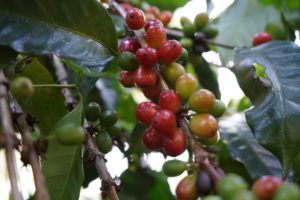Although today coffee and tea are the classic energizing drinks in most of the world, a unique beverage similar to coffee used to be king in a large region of the Americas. Chili peppers spiced up this liquid. Maté, the South American tea, is a great guess, but it’s not spicy. Many people are surprised to learn that before the equatorial “coffee belt” expanded into Central and South America during the colonial period, the coffee-like crop cacao was already being grown and consumed in Central America and Mexico. It was brewed into a beverage named Xocolatl.

Today we know cacao from one of the world’s favorite sweets: chocolate. Although it may seem like a little twist in spelling from cocoa and not much more interesting, cacao actually has a fascinating history. It was even used as currency!
The ancient drink made from cacao has both similarities and differences to coffee. The main difference was, of course, the spice! Like coffee, cacao also grows on a tree and energizes people who drink it. However, cacao was much more important in precolonial culture than coffee has ever been in any culture. It’s ironic that now people are researching directly how to get coffee from Honduras, Guatemala and Mexico when cacao used to be treated as sacred in this region.
Coffee and Cacao’s Different Origins
Coffee originated in Ethiopia centuries ago. However, the date and length of time it was consumed before the first known cultivation remain murky to historians. It was first grown in Yemen about 500 years ago. Then it made its way eastward. It spread throughout Europe and to the New World. Meanwhile, cacao seems to have grown in the tropics of Mesoamerica since the BC era (the date is debated).
The original native American names for cacao vary slightly from one another. In the Mayan language, it was known as “kawkaw.” Meanwhile, “cacaua” was the name in Nahuatl, which was spoken in central and western Mexico. The natives’ drink, which was roughly similar to hot chocolate, but spicy, was Xocolatl. “Xoco” indicates bitterness in Nahuatl. “Atl” means water.
Similar Growth
Both coffee and cacao grow on trees in tropical regions. Many people don’t realize that coffee “beans” are actually the seeds of a coffee fruit grown on a tree. They’re more like a cherry stone than a black bean or lima bean. Also, coffee trees don’t grow well further north, so people now buy coffee from the former area where cacao used to dominate. People who care more about buying responsibly and specifically are searching for themselves how to get coffee from Honduras and nearby countries.
While coffee trees can grow tall when not pruned, with the cherries living the high life, cacao grows in an oblong pod at the base of a cacao tree. The pod is large, bumpy and thick-skinned. It turns from yellow and green to dark brown as it matures. Inside are the cacao beans, which are dried and fermented.
Different Preparations
There are fewer coffee-based products that use ground coffee beans than cacao. Cacao appears in a much wider variety of foods and forms. Cocoa butter is one form. It’s used as a skin moisturizer. Indigenous foods like the sauce mole (moh-lé) also use cacao. Mole is Mexico’s national dish, and it’s often served with rice and different meats.
Meanwhile, coffee beans have primarily been used for brewing the hot beverage coffee. Cacao added to liquid was more versatile. Chile and spices could make this drink have a strong kick to it. It was also commonly mixed with milk and sweeteners, making it more like the hot chocolate we know today. Only recently has coffee commonly made its way into candy, ice cream and other foods. Cacao has more considerable health advantages, while coffee is roughly neutral except for containing antioxidants.
Culture of Cacao and Coffee
Both beverages have been celebrated in many cultures. In some countries, “bean-based” beverages (actually seed-based) even have a culture surrounding them. People don’t take their energizing effects or their rich tastes for granted. Mediterranean folks sure love their coffee, but is it really a culture? Coffee’s cultural aura has generally been less pronounced than cacao’s full integration into Mesoamerican (now Mexican and Central American) culture. The customs surrounding coffee changed as it flowed to different countries through trade centuries ago. The intensity of the love for coffee varies.
Cacao’s Native American Heritage
The history of cacao is closely tied to indigenous civilizations and heritage. Cacao was part and parcel of Mesoamerican culture. The gods played a role in bringing cacao to the Aztecs and Maya, according to their cultures. The nobles sometimes hoarded it for themselves. Cacao was given as a gift and even used as a dowry for brides. It served as a currency in some cases.
Coffee and Cacao Mixing In Importance in Central America
Coffee arrived to Central America in the colonial period. It has certainly usurped territory as the most popular energizing beverage. The net effect is that many countries have seen coffee flow into their culture and daily habits, while the older, more native cacao is no longer the drink of choice. Cacao, however, is still featured in foods.
Coffee has been grown in Central America and Honduras for some time. In certain areas, it arrived in the mid-eighteenth century. In others, it wasn’t planted until the turn of the century. Most central Americans are very proud of their coffee.
Economic Benefits of Coffee Expansion

While it is sad that a beverage originally from Ethiopia brought over by colonists grew more popular than the native cacao, coffee has earned an important place in Central America. It helps propel the economies of some of these small countries. In fact, it is often the most lucrative export or the most lucrative agricultural product. In most countries, it remains within the top five. Coffee is growing more popular in the world. As demand rises, Central American powerhouse regions of coffee, like the network of small Honduran coffee farms, are positioned to meet demand and prosper in the process.
Honduras is the leading exporter of coffee in Central America. Coffee plays a big role in the Honduran economy. Its coffee exports make up 5% of total GDP. Of agricultural GDP, coffee comprises 30%. Small farmers grow most coffee, which helps spread wealth throughout the country. Guatemala is another country ranking in the top ten coffee producers worldwide.
People are surprised that Mexico and Honduras’ high-altitude coffee can be as tasty as South American coffee grown high up in the mountains. In fact, Honduras’ arabica is standing out more and more. Single-origin coffees have become so competitive that people are asking how to get coffee from Honduras, especially from the Copán region. Cacao used to reign here with the Maya. This area is the southern end of the strings of Mayan ruins throughout Central America.
How to Get Coffee from Honduras
Coffee from Honduras can arrive regularly. A single-origin roasted in small batches with care, Subida Coffee Co. supports a non-profit. The medium roast evokes cacao a bit, with its chocolate notes. Sweet citrus flavor does pay homage to its coffee fruit origins. Best of all, the greater non-profit that Subida is a part of supports the local Honduran community.

